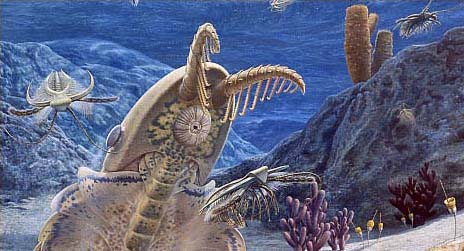 |
 |
 |
 |
 |
Produced
by the Population Genetics and Evolution class, Furman University |
||||
 |
 |
 |
 |
 |
Produced
by the Population Genetics and Evolution class, Furman University |
||||
 |
The
Cambrian: Marella |
 |
||
| Marella
is an arthropod fossil that was discovered by Charles Doolittle Walcott
at the Burgess Shale Formation in British Columbia, Canada (Fossil Museum).
Marella existed over 520 mya in the Early Cambrian period. It
possess a head shield which consists of “two pair of large curving
spines” (Fossil Museum). Anterior to the head shield is another
pair which projects out to the side, and anterior to that is another pair
that extends the length of the body (Fossil Museum). There are many body
segments, which “possess identical biramous appendages with feathery
filaments that were used in respiration” (Fossil Museum). Moreover,
Marella has a pair of “rearward” spikes and a pair
of antenna connected to the head shield (Wikipedia 2009). Furthermore,
each appendage has two branches. The top branch is a gill used for respiration
and the bottom branch is a leg (Wikipedia 2009). 20 segments of akimbo
pairs of legs and gills make up a triangular body that tapers at the back
(Ludvigsen and Chatterton 2008). Marella was a benthic organism, which means that
it survived by living on or near the ocean floor (Fossil Museum).
Page by Matt Medlin |
 |
| Marella fossil. from: world mysteries | |
|
Fossil
Museum. 2010. Burgess Shale: Marella splendens. Accessed
February 2010. Wikipedia. 2009. Marella. Ludvigsen R, Chatterton B. 2008. Marella and the Burgess Shale. Past Lives: Chronicles of Canadian Paleontology. Geological Survey of Canada. Accessed February, 2010. |